
The Hilandar Monastery is one of the twenty Eastern Orthodox monasteries in Mount Athos in Greece and the only Serbian monastery there. It was founded in 1198 by Stefan Nemanja and his son Saint Sava. St. Symeon was the former Grand Prince of Serbia (1166–1196) who upon relinquishing his throne took monastic vows and became an ordinary monk. He joined his son Saint Sava who was already in Mount Athos and who later became the first Archbishop of Serbia. Upon its foundation, the monastery became a focal point of the Serbian religious and cultural life, as well as assumed the role of "the first Serbian university". It is ranked fourth in the Athonite hierarchy of 20 sovereign monasteries. The Mother of God through her Icon of the Three Hands (Trojeručica) is considered the monastery's abbess.

The Sacred Patriarchal and Stauropegic Monastery Esphigmenou is an Eastern Orthodox monastery dedicated to the Ascension of Christ in the monastic state of Mount Athos in Greece. It is built next to the sea at the northern part of the Athonite peninsula. Located near the Hilandar monastery, it is the northernmost of all Athonite monasteries. The current monastery dates back to the 10th century, while tradition holds that the site had been used as a monastery since as early as the 5th century. Esphigmenou ranks eighteenth in the hierarchy of the Athonite monasteries and since the early 1970s has been embroiled in legal and ecclesiastical disputes. It is considered amongst the most conservative of the monastic houses on Mount Athos.
Kallistos I was the Ecumenical Patriarch of Constantinople for two periods from June 1350 to 1353 and from 1354 to 1363. Kallistos I was an Athonite monk and supporter of Gregory Palamas. He died in Constantinople in 1363.

Athanasius the Athonite, was a Byzantine monk who is considered the founder of the monastic community on the peninsula of Mount Athos, which has since evolved into the greatest centre of Eastern Orthodox monasticism.
Imiaslavie or Imiabozhie (Имябожие), also spelled imyaslavie and imyabozhie, and also referred to as onomatodoxy, is a Christian dogmatic movement that asserts that the name of God is God Himself. The movement emerged early in the 20th century, but both proponents and opponents cite alleged antecedents throughout the history of Christianity. Advocates claim that the idea is traceable to the Church Fathers, while opponents claim to trace it to ancient heresiarchs.
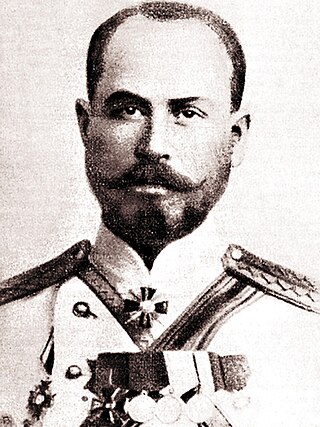
Alexander Ksaverievich Bulatovich tonsured Father Antony was a Russian military officer, explorer of Africa, writer, hieromonk and the leader of the imiaslavie movement in Eastern Orthodox Christianity.

Eastern Christian monasticism is the life followed by monks and nuns of the Eastern Orthodox Church, Oriental Orthodoxy, the Church of the East and Eastern Catholicism. Eastern monasticism is founded on the Rule of St Basil and is sometimes thus referred to as Basilian.
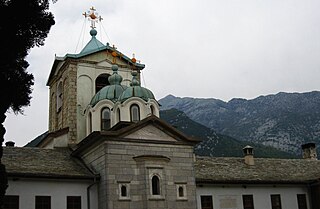
The Skete of Prodromos is a Romanian cenobitic skete belonging to the Great Lavra Monastery. It is located in the southeastern extremity of Mount Athos, near the cave of Athanasios the Athonite. Its name, Prodromos, is Greek for "The Forerunner", a cognomen of St. John the Baptist.
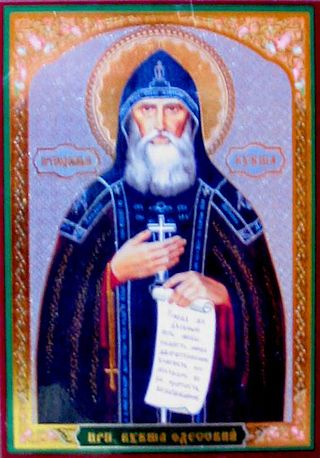
Kuksha of Odessa, born Kuzma Kirillovich Velichko, was an imperial Russian priest and a Ukrainian Orthodox Church saint who was canonized in 1995.
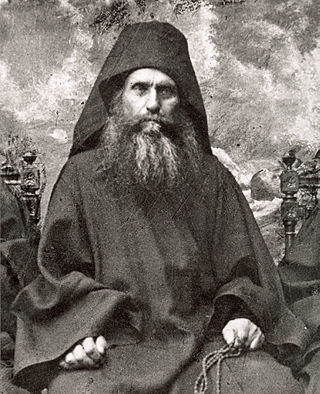
Silouan the Athonite also sometimes referred to as Silouan of Athos, Saint Silvanus the Athonite or Staretz Silouan was an Eastern Orthodox monk of Russian origin, born Simeon Ivanovich Antonov who was a poet and monk of the St. Panteleimon Monastery.
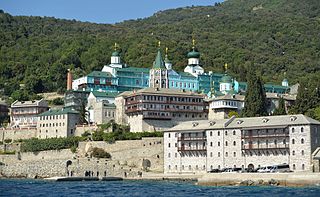
Saint Panteleimon Monastery, also known as Rossikon or New Russik, is one of the twenty Eastern Orthodox monasteries on Mount Athos, located on the southwestern side of the peninsula in Northern Greece. It is the Russian monastery on the peninsula. It houses exclusively Russian monks, sent by the Russian Orthodox Church, and the liturgies are served in Russian, despite the fact that all monks on Mount Athos eventually become citizens of Greece.
Paisios of Mount Athos, was a well-known Greek Eastern Orthodox ascetic from Mount Athos, originally from Pharasa, Cappadocia. He was respected for his spiritual guidance and ascetic life. Today, he is widely venerated by Eastern Orthodox Christians, particularly in Greece, Russia and Syria.

Saint Sava, known as the Enlightener, was a Serbian prince and Orthodox monk, the first Archbishop of the autocephalous Serbian Church, the founder of Serbian law, and a diplomat. Sava, born as Rastko Nemanjić, was the youngest son of Serbian Grand Prince Stefan Nemanja, and ruled the appanage of Zachlumia briefly in 1190–92. He then left for Mount Athos, where he became a monk with the name Sava (Sabbas). At Athos he established the monastery of Hilandar, which became one of the most important cultural and religious centres of the Serbian people. In 1219 the Patriarchate exiled in Nicea recognized him as the first Serbian Archbishop, and in the same year he authored the oldest known constitution of Serbia, the Zakonopravilo nomocanon, thus securing full religious and political independence. Sava is regarded as the founder of Serbian medieval literature.

December 4 - Eastern Orthodox liturgical calendar - December 6
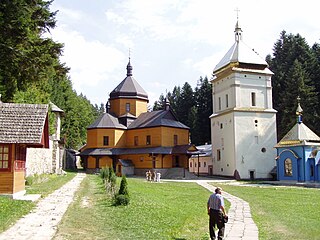
Manyava Skete of the Exaltation of the Holy Cross, - otherwise known as Ukrainian Athos, is an Orthodox solitary-cell men's monastery (skete) in the Carpathian mountains of western Ukraine. It is situated on the outskirts of the village of Maniava in Ivano-Frankivsk Raion of Ivano-Frankivsk Oblast and belongs to the Ukrainian Orthodox Church of Kyiv Patriarchate. Hegumen of the monastery is Ioasaf, metropolitan of Ivano-Frankivsk and Halych. Currently there are 8 monks residing at the monastery.
Bogoroditsa is a skete of the Agiou Panteleimonos monastery in the monastic state of Mount Athos, Greece.
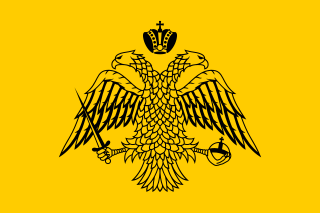
The monastic community of Mount Athos is an Eastern Orthodox community of monks in Greece who hold the status of an autonomous region as well as the combined rights of a decentralized administration, a region and a municipality, with a territory encompassing the distal part of the Athos peninsula including Mount Athos. The bordering proximal part of the peninsula belongs to the regular Aristotelis community in Central Macedonia.
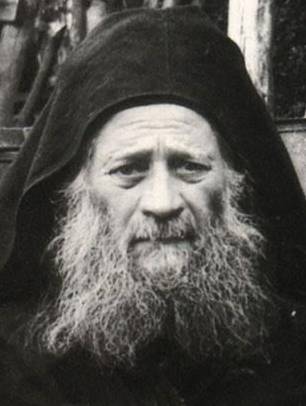
Joseph the Hesychast was a Greek Orthodox monk and elder who led a small group of monks at Mount Athos. He was canonized as a saint by the Ecumenical Patriarchate of Constantinople in 2020. His annual feast is celebrated on August 16.
Saint Daniel Katounakiotis of Smyrna was a Greek Orthodox monk who lived on Mount Athos. He was canonized as a saint by the Ecumenical Patriarchate of Constantinople in 2020. His feast is commemorated on September 7.
Mount Athos has an extensive network of footpaths, many of which date back to the Byzantine period. These paths are typically trails designed for human foot traffic and mules, and are not wide enough for motor vehicles. They connect the various monasteries, sketes, cells, kathismas, and hermitages on the peninsula to each other.

















